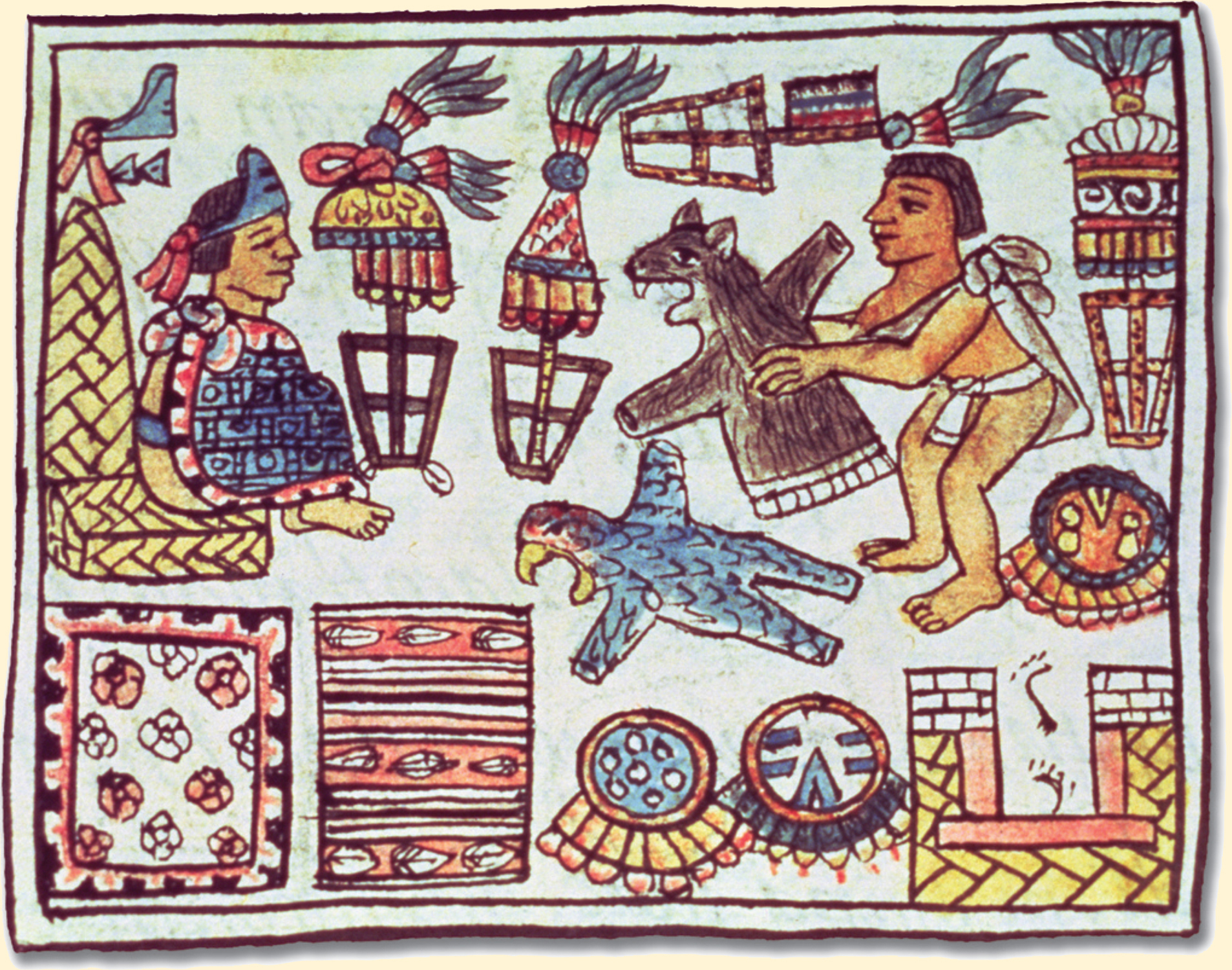The American Promise:
Printed Page 42
SEEKING THE AMERICAN PROMISE
Spreading Christianity in New Spain
Spanish officials aspired to accompany the military and political conquest of the New World with spiritual conquest. With royal support, priests flocked to New Spain to save the millions of souls unexpectedly disclosed by the voyages of Columbus. In 1529, a young priest named Bernardino de Sahagún sailed to New Spain, where he spent the remaining sixty-

Sahagún believed that preaching the gospel in the New World was a heaven-
Sahagún and other Spaniards considered Christianity the one true faith. When Cortés and his men marched into Mexico a decade before Sahagún arrived, they went out of their way to destroy effigies of Mexican gods and to replace them with crosses, the icons of Christianity. “It was necessary,” Sahagún wrote, “to destroy the idolatrous things, and all the idolatrous buildings, and even the customs of the [Mexicans] . . . that were intertwined with idolatrous rites and accompanied by idolatrous ceremonies.”
What Sahagún considered idolatry was rooted in individual Mexicans’ belief in what he called their own “innumerable insanities and gods without number.” Sahagún and other priests set out to persuade the Indians to reject belief in traditional deities and to have faith instead in the divinity of Jesus Christ and in the Catholic Church as Christ’s representative on earth.
At first, the conversion campaign seemed amazingly successful. One priest claimed that more than nine million Mexicans had been baptized by 1539. But after a few years, Sahagún and other priests realized that many Indians simply “took [Jesus Christ] as yet another god . . . without . . . relinquishing their ancient gods.” Adopting some of the outward rituals of Christianity while maintaining belief in what Spaniards considered pagan idols was a “twisted perversity,” Sahagún wrote, one that caused the New World church “to be founded on falsehood.”
Unlike many other Spaniards, Sahagún believed that in order to purge Mexicans’ idolatries, church leaders needed to become familiar with Mexicans’ traditional religious ideas. To diagnose what he called the Mexicans’ “spiritual illnesses,” Sahagún set out to record everything he could learn about the Indians’ beliefs.
As a first step, Sahagún learned Nahuatl, the Mexicans’ unwritten language. Next, he and other priests started schools to teach Latin and eventually Spanish to young Indian students, usually drawn from elite families. These “trilinguals,” as Sahagún called them, could translate religious texts into Nahuatl, which the priests could use in their missionary efforts.
Beginning in 1558, Sahagún used his trilinguals to undertake a systematic investigation of every facet of Mexican life. Sahagún and his assistants interviewed Mexican elders, asking them not only about gods and religious ceremonies but also about farming, family life, education, poetry, songs, and even their conquest by the Spaniards. Sahagún developed great admiration for both the Mexicans and their language. “They are quick to learn,” he wrote. “There is no art for which they do not have the talent to learn and use it.” In fact, Sahagún declared, the Mexicans “are held to be barbarians and a people of little worth, yet in truth, in matters of culture, they are a step ahead of many nations that presume to be civilized.”
For years, Sahagún edited and organized this massive treasure trove of information about Mexican life and beliefs, all in the hope that it would ultimately help priests make converts to Christianity. When church officials heard about Sahagún’s great work, they obtained a royal order in 1577 to collect all copies and send them immediately to Spain for destruction. The Spanish monarchy and most church officials wanted to stamp out the Mexicans’ beliefs, not preserve them. Sahagún dutifully sent his volumes to Spain, but he was still working on a final copy, which he later gave to a priest friend, who saved it, and it survives to this day. Unbeknownst to him, Sahagún’s masterwork preserved for posterity an unrivaled account of the hearts and souls of sixteenth-
Questions for Consideration
- In what ways did Sahagún’s work contribute to the conquest of Mexico?
- What did Sahagún believe about the global significance of his missionary work? How might his “trilinguals” and Mexican informants have interpreted his efforts?
Connect to the Big Idea
What ideas about the Mexicans did Sahagún hold in common with the Spanish monarchy, royal officials, and other Catholic missionaries? To what extent did his ideas conflict with those held by other Spaniards?